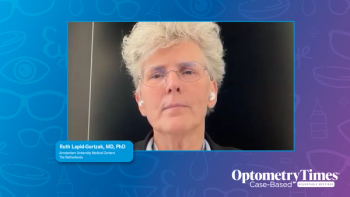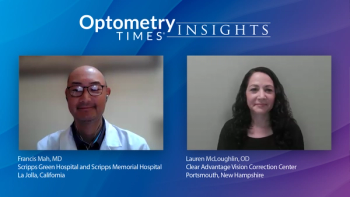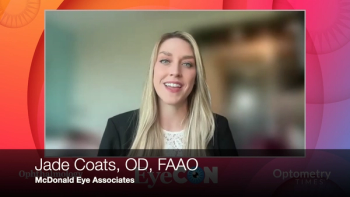
Geographic atrophy, pegcetacoplan, and the future of care with Dr. Euin Cheong
Euin Cheong, OD, weighs in on the Syfvore approval for geographic atrophy and how optometrists should participate in geographic atrophy care.
Video transcript
Emily Kaiser:
Hi everyone, I'm Emily Kaiser with Optometry Times and I'm sitting down with Dr. Euin Cheong to talk about
Euin Cheong, OD:
Alright, hello, everyone. I'm Dr. Euin Cheong, and I'm a low vision and primary care optometrist at Lexington Eye Associates in Massachusetts. Macular degeneration is a very, very common eye disease, as we all know, and optometrists are often the very first to discover the beginning stages of it, whether it's little bits of drusen, or just full-blown, advanced macular degeneration. Patients often come to optometrists for glasses or contacts for vision relief, and then find that, to their surprise, they are diagnosed with macular degeneration. So we're often on the front lines of the diagnosis and the referrals.
Kaiser:
And what are your thoughts on the pegcetacoplan approval from Apellis?
Cheong:
I think it's a very exciting launch. You know, it's been almost 2 decades of treatment for wet
And I think this is just the beginning of treatments for dry AMD. And I'm also looking forward to future research and treatments just going on top of this current treatment. I think the biggest change will be that we can finally give our patients hope in that their vision is just not a slippery slope of vision loss, and that they can hold on to some sort of functionality with their vision and their eyesight. And as long as they're adhering to the monthly or every-other-month injections that they can still enjoy the activity they do every single day, and that they can still see faces of loved ones.
Kaiser:
And what can optometrists do to improve their care of patients geographic atrophy?
Cheong:
I think the biggest thing is that thus far, when we take
Kaiser:
Do you anticipate that this approval of pegcetacoplan will change the co-management of patients with geographic atrophy?
Cheong:
I think it will. I think it'll help us build a tighter relationship with our retinal specialists. I'm sure all optometrists have, you know, a handful of retinal specialists that they love referring patients to. Our retinal specialists will be swamped more than ever, with millions of people who will suffer from geographic atrophy. And I think it's important for us to make sure we have enough specialists to refer to and also be able to build proper communication bridges with our retinal specialists, so that we can seamlessly co-manage in between injections as well.
Kaiser:
Fantastic. Is there anything else that you want to bring up that we haven't touched on?
Cheong:
One important thing, especially as a low vision specialist, is functionality of vision. And I think with the launch of any treatment for dry macular degeneration, it will really allow patients to hold on to that. You know, there are some studies with the Oak and Derby trials that really show the microperimetry and how, you know, the injections allow patients to preserve certain pockets of their macula. It's really special. It's a really special medication. And I'm looking forward to patients just having more hope regarding their vision and have—building that relationship with their doctors so that they can preserve as much as they can.
Kaiser:
Well, thank you so much for taking the time to chat today. I can't wait to hear more as we venture down this path and find better and more abundant treatment options for geographic atrophy.
Cheong:
Yeah, same here. This is exciting. It's a big deal for eye care. So looking forward to more research being done as well, yeah.
Kaiser:
Absolutely. All right. Thank you.
Cheong:
Thank you.
Newsletter
Want more insights like this? Subscribe to Optometry Times and get clinical pearls and practice tips delivered straight to your inbox.


















































.png)


